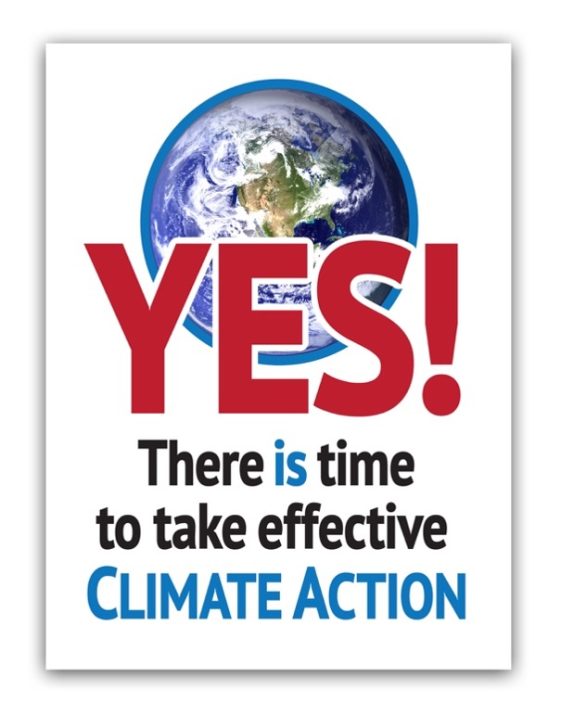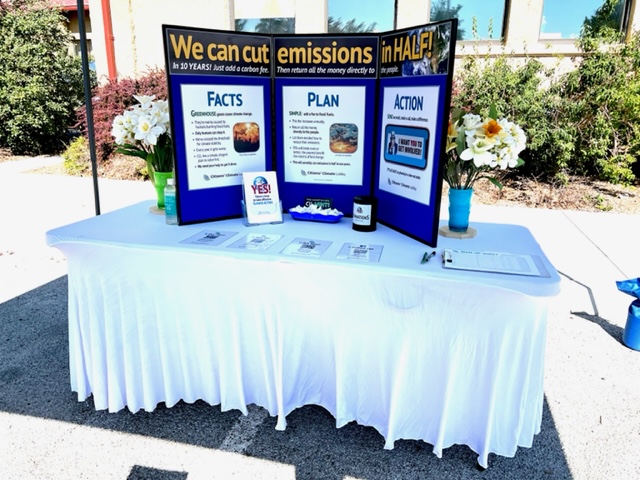Reno/Sparks Chapter Redesigns “Tabling”
Wayne asked me to share the process I went through rethinking our tabling approach for our post-COVID relaunch. In that process, I challenged virtually all the assumptions we had built our previous display from, so the process cannot be distilled into any single concept. So, if you read on, don’t say I didn’t warn you!
As I see it, our existing display was based on assumptions that seemed intuitively appropriate in the pre-COVID era:
- Climate change was not well understood or generally accepted.
- It needed to be explained scientifically.
- Once understood and accepted, people would want a logical solution.
- The EICDA was a logical solution so, once explained, people would support it.
A lot has changed in the last three years.
- Climate change has made itself known to the public. After being pounded year afteryear with increasingly relentless superstorms, biblical flooding, raging wildfires, blistering heat domes, droughts drying up lakes and reservoirs, it is now accepted as a real phenomenon by the majority of Americans.
- The psychology of climate change acceptance has been explored in greater depth and is often counterintuitive; meaning the data-based approach that brought many of us into climate activism not only doesn’t work for most people it can even reinforce denial.
- It also reveals there are very few motivational approaches that DO work, even when people accept the reality of climate change.
The book I used as my guide through this process was “Don’t Even Think About It” by George Marshall. (See my synopsis of the book here.) I recommend it for anyone who hasn’t read it, although it’s a slough. After reading it (twice) my most basic conclusions:
- People need hope, yet for most people addressing climate change appears hopeless.
- Climate change appears hopeless because it’s so overwhelming—deeply interwoven into the global economic/energy infrastructure; amorphous; hydra-headed; demanding crushing personal sacrifice; corrupted by disinformation; beyond the reach of average people to influence—so that once people accept it, they need something they can do RIGHT NOW that is significant to address it. Otherwise, some form of hopeless apathy
sets in.
Based on this research and working with our group of activists, I came up with this graphic statement to reframe confronting the issue:
 “Yes” is the most powerful positive word in English, so we led with that. The earth image with the blue “climate ring” in the background ties “yes” to climate change and the statement is hopeful without overpromising. This became our brand. We made a vertical display based on this, our handout, and the tee-shirts for our volunteers.
“Yes” is the most powerful positive word in English, so we led with that. The earth image with the blue “climate ring” in the background ties “yes” to climate change and the statement is hopeful without overpromising. This became our brand. We made a vertical display based on this, our handout, and the tee-shirts for our volunteers.
Next up was simplifying our tri-fold display panels. I removed all the technical charts and graphs and replaced them with a sequence of three panels briefly outlining three steps: Facts, Plan and Action.

Also, on the table I designed four laminated sheets with QR codes (and written-out URLs) for people to photograph and a flyer with the same information they could take. These were links to:
- Learning about CCL and the EICDA
- Joining CCL
- Signing up for the Monthly Calling Campaign
- Following our Facebook page
I also went out of my way to further soften (de-nerdify) the table appearance by adding two bouquets of artificial flowers (you can imagine the ruckus that aroused in our group, ironic since all the other exhibit components—tables, chairs, displays—are essentially 95% plastic). I also ordered a white table skirt that hangs in ruffles. I don’t know if those touches made any appreciable difference to the display’s attractiveness, but they didn’t hurt. To me, it felt much more friendly and approachable.
I then incorporated two concepts that had worked extremely well in our previous design: a children’s climate coloring table and a whiteboard chart based on Hahrie Han’s 6-levels of climate concern where people could “vote.” These are almost magical “people magnets” and icebreakers. Put together, the exhibit looks like this:

HOW IT WORKS
Because of the profound shift in public awareness around climate change over the last few years, our new approach is not to convince anybody about anything. I tell our volunteers, “We are looking for the people who are looking for us.” Here is our “public engagement” sequence:
- We present ourselves as an embodiment of climate hope.
- We generally attract people through the Han chart or children’s drawing table, the chart being the most popular. If families enter through the drawing table, we steer the parents to the chart, and go from there.
- When people “vote” it is almost always “alarm.” If they indicate they are not concerned, we thank them for their input and send them on their way. If they are in the “concerned/alarmed” category we encourage them to say more, engaging them more personally, building rapport and getting their buy-in.
- Then, the “ask” is this: are they willing to commit to 5 minutes a month, every month, to make three calls to congress (“as easy as phoning in a takeout order”)? For me, this is critical for three reasons:
- It gives them a tangible action that breaks the overwhelming nature of the crisis into something simple they can accomplish that is meaningful.
- It leads to signups already committed to action.
- That initial commitment can become a foundation for deeper CCL engagement in the future.
- This “ask” component has exceeded my expectations. People appear eager, even relieved to be given something to do—a pleasant surprise.
- This leads to a signup. I’ve also redesigned the signup sheet with little boxes for people to print in. Our previous form featured open rectangles that encouraged illegible scrawls and the boxes have tamed that impulse. Although we are still refining the contact section for follow up, it basically looks like this:
Here’s what we no longer do:
- Try to convince anybody about anything.
- Try to sell the carbon fee concept. I find it generally too detailed and abstract a plan to explain standing in a public arena. Some people want to know, and the tri-panel display is there to introduce the very basics, and of course volunteers know enough to answer any questions. However, it turns out most people are not interested, even in the simplified tri-fold explanation, they just want something to DO.
- Lead with CCL. Very few people have heard of us so don’t really care about us. The CCL logo is present on the panels and elsewhere to ground our activism in a larger structure, but not to lead the discussion.
The way I see it is this:
- These days, most people are leading lives of quiet climate desperation.
- Our display and presence offers climate hope.
- We offer a simple, meaningful action to validate that hope.
- Also, we let them know we are volunteers with a larger organization/plan/effort they can learn more about later. Also, that CCL is free to join and doesn’t fill their inbox with spam or pleas for money.
- What matters NOW is to commit to an action you can do.
CONCLUSION
People are responding to our new exhibit and approach positively, even enthusiastically, so I think we are succeeding. We’ve field tested it three times, for 4-hours each stretch, at the local farmers market and each time garnered more signups—averaging nearly 10 (seemingly enthusiastic) signatures each outing.
My underlying goal for all this work is to recruit more active members. There was a point in CCL’s development where it was important to show legislators how many “members” our CCL chapter had—whether they did anything or not. I think we’ve passed that point. Our Reno/Sparks chapter needs to double its active membership to avoid burnout. We are running on empty, which to me, in this current era of rising climate alarm, is almost nonsensical. Many people, whether they know it or not, are looking for us; we just need to help them find us, get them energized and engaged, and then build the political will to fundamentally address the causes of climate change. This new exhibit is a step in that direction. And it’s a work in progress…
Questions or comments:
Billmiller1221@gmail.com
509-850-2550

